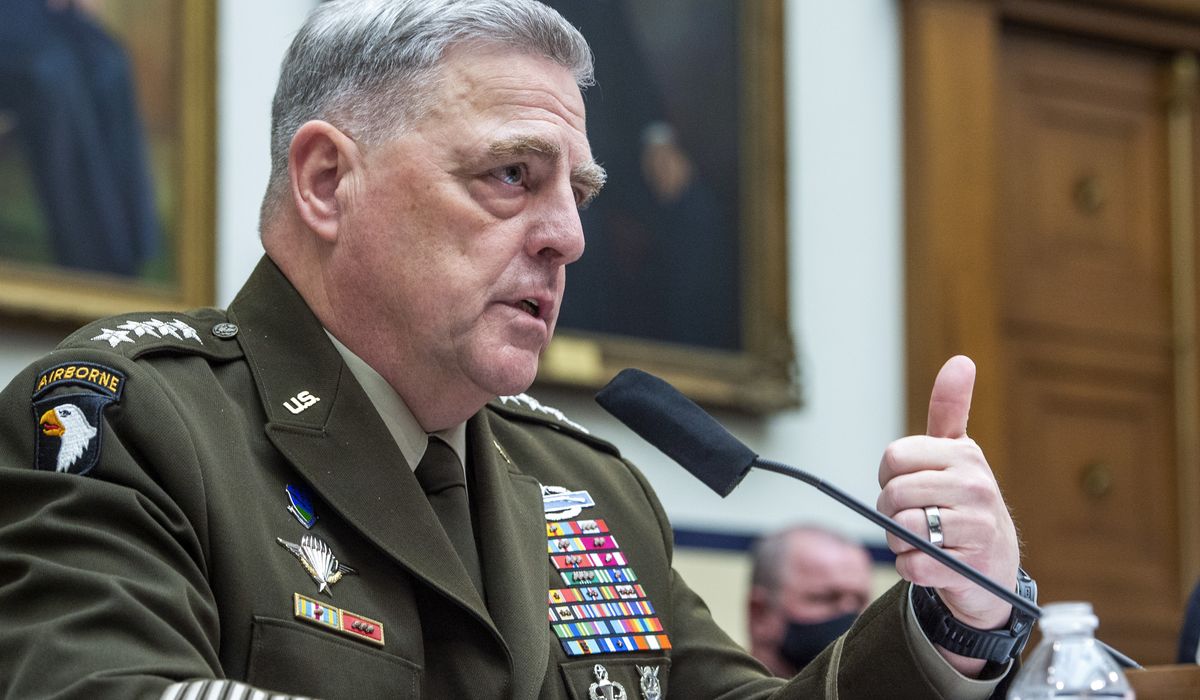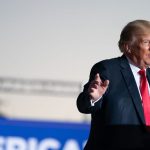
China’s recent test of a major hypersonic weapon system is “very close” to a “Sputnik moment” in the standoff between the U.S. and its global rival, America’s top general said in an interview that aired Wednesday, conceding that Beijing’s rapidly expanding military capabilities are of deep concern at the highest levels of the Pentagon.
Speaking to Bloomberg Television’s “The David Rubenstein Show: Peer-to-Peer Conversations” program, Joint Chiefs of Staff Chairman Gen. Mark A. Milley confirmed reports that China conducted a landmark test of its hypersonic weapons program this summer.
Chinese Communist Party leaders have denied those reports and said the object was merely a spacecraft.
Gen. Milley shot down those claims. To describe the significance of the event, he reached back to a Cold War watershed moment when the Soviet Union stunned the world by launching the first satellite into orbit.
Although he did not discuss details, the general acknowledged that the test marked a “significant technological event” that underscores how much progress China has made in the past decade with its hypersonic program and a host of other military domains.
“What we saw was a very significant event of a test of a hypersonic weapon system, and it is very concerning. I don’t know if it’s quite a Sputnik moment, but I think it’s very close to that,” he said. The launch of Sputnik in 1957 sparked a military buildup and a space race between Moscow and Washington.
“It’s a very significant technological event that occurred, or test that occurred, by the Chinese, and it has all of our attention,” Gen. Milley said. “But that’s just one weapons system. The Chinese military capabilities are much greater than that. They’re expanding rapidly in space, cyber and then in the traditional domains of land, sea and air. And they have gone from a peasant-based infantry army … to a very capable military that covers all of the domains and has global ambitions. So, China is very significant on our horizon.”
The Financial Times, citing unidentified defense officials, was the first to report this month on the Chinese tests.
Gen. Milley did not dispute reports that the hypersonic missile launched into space by the Chinese military is capable of carrying a nuclear payload, making it exponentially more dangerous and adding even more pressure to high-stakes programs deep inside the Defense Department to build missile defense systems able to counter hypersonic technology. Many private analysts say this is one critical field in which both China and Russia have outpaced the U.S.
Hours after the Gen. Milley interview aired, chief Pentagon spokesman John Kirby reiterated the dangers of China’s growing military prowess.
“We remain concerned about China’s advancement of certain capabilities,” he told reporters at a Pentagon press conference Wednesday afternoon. “They have a global reach that we have to be careful about and mindful of.”
Pentagon leaders have been careful to avoid discussing specific comparisons between American and Chinese hypersonic technology. Still, the most recent test will fuel fears that China’s programs are on par with or perhaps beyond those of the U.S. It’s unclear whether military leadership was aware that China possessed the level of hypersonic capabilities on display in the most recent round of tests.
Hypersonic weapons are maneuverable and able to travel at five times the speed of sound. Many say the technology is a game-changer in 21st-century warfare. If the Chinese are able to launch nuclear-armed hypersonic weapons into orbit, they could have the ability to strike targets around the world while evading even the most cutting-edge U.S. missile defense systems.
Grave challenges
U.S. military leaders are well aware of the grave challenges posed by Chinese and Russian hypersonic programs. Russian President Vladimir Putin has bragged that his country’s Avangard hypersonic system can defeat all existing defense systems.
Pentagon budgets have dramatically ramped up hypersonics funding. The Defense Department’s fiscal year 2022 budget called for at least $3.8 billion for hypersonics programs as a “down payment” on the weapons systems of the future.
Last week, U.S. researchers launched a salvo of rockets from NASA’s Wallops Flight Facility in Virginia as part of the Pentagon’s plan to develop hypersonic missiles for the Navy and Army.
“These launches allow for frequent and regular flight testing opportunities to support rapid maturation of offensive and defensive hypersonic technologies,” Navy officials said in a statement.
Pentagon officials said they plan to field operational hypersonic systems by the early to mid-2020s. Defense Department leaders have stressed that the U.S. is developing non-nuclear hypersonic strike capabilities, unlike China and Russia.
Chinese officials have flatly denied testing hypersonic weapons and say the U.S. is guilty of a double standard by condemning foreign hypersonics research while rapidly pursuing the same technology.
“We have noted that the U.S. expressed concerns over China’s normal spacecraft test and play up the ‘China threat’ theory. Can the U.S. explain to the international community what it intends to do with its development of hypersonic weapons?” Chinese Foreign Ministry spokesperson Wang Wenbin said last week.
“And for what reason does the U.S. worry about others? Does that mean the international community has every reason to express concerns over U.S. moves?” he said.
U.S. lawmakers this week said China’s hypersonic test should sound alarm bells on other fronts as well.
Republican members of the House’s China task force sent a letter late last week telling Commerce Secretary Gina Raimondo that the U.S. needs to tighten its export control policy. Otherwise, they said, the Chinese regime could use American technology to advance its own dangerous weapons programs.
“Reports that [China] has tested a nuclear-capable hypersonic missile is a chilling display of Chinese Communist Party capabilities and intentions. To make matters worse, it is likely that U.S. software and tools contributed to the creation of this weapons system, because of our country’s permissive export controls and licensing policies with China,” task force Chairman Michael T. McCaul, Texas Republican, and his colleagues wrote.
“If this is not the clarion call to overhaul export controls … liberal democracies may cede more ground to a genocidal, authoritarian regime,” they said.
• Mike Glenn contributed to this report.








